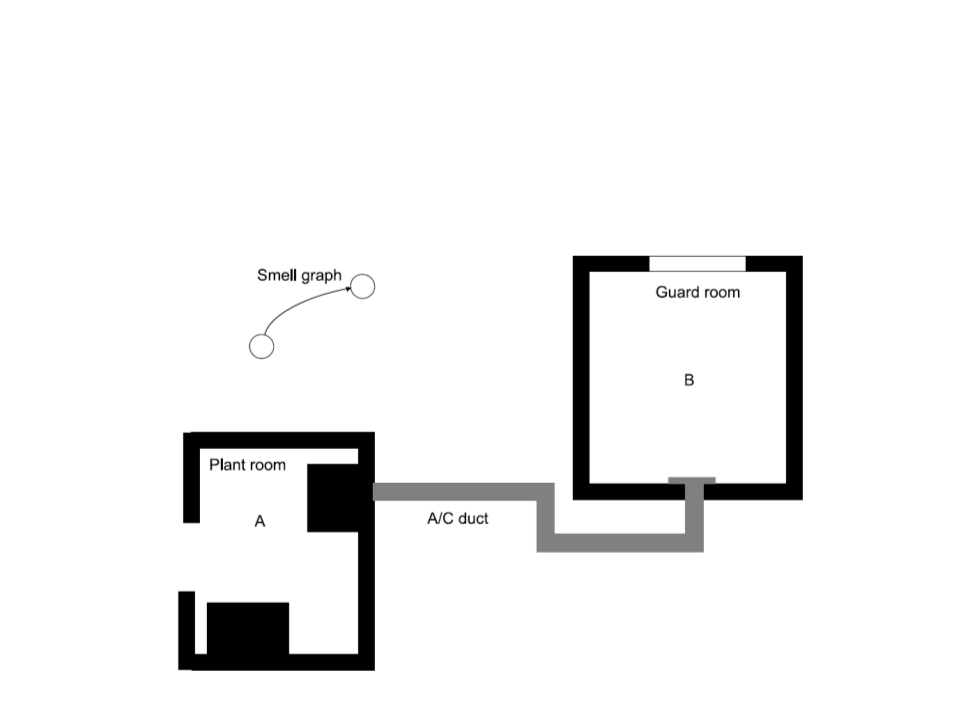
Artificial Intelligence
Lecture 08 – Sensor Systems
Edirlei Soares de Lima
<edirlei.lima@universidadeeuropeia.pt>

Game AI – Model
•
•
•
•
•
•
•
•
Pathfinding
Steering behaviours
Finite state machines
Automated planning
Behaviour trees
Randomness
Sensor systems
Machine learning

Decision Making
•
•
In game AI, decision making is the ability
of a character/agent to decide what to
do.
The agent processes a set of information
that it uses to generate an action that it
wants to carry out.
–
Input: agent’s knowledge about the world;
–
Output: an action request;

Decision Making
•
The knowledge can be broken down into external and
internal knowledge.
–
External knowledge: information about the game environment (e.g.
characters’ positions, level layout, noise direction).
–
Internal knowledge: information about the character’s internal state
(e.g. health, goals, last actions).

Sensing Information
•
•
Game environments simulate the
physical world, at least to some degree.
–
In the real world, a person gains information
about its environment by using its senses.
If a loud noise is generated in the game,
all characters that are close to the event
must “hear the sound”.
–
However, a character across the other end
of the level may not heard it, and neither
would a character behind a soundproof
window.

Sensing Information
•
•
Is not possible to make a real simulation of how biological
sensors work. Simplifications are indispensable.
–
There is no point in simulating the way that sound travels from the
headphones on a character’s head down its ear canal.
Example:
–
A character might be constantly looking at the position of the player.
When the player gets near enough, the character suddenly engages its
chase” action.
–
“
–
It appears to the player as if the character couldn’t see the player until
he got close enough.

Sensory Modalities
•
Four natural human senses are suitable for use in a game (in
roughly decreasing order of use):
–
–
–
–
Sight: the ability of character to see. Players can easily tell if it is being
simulated badly.
Touch: the ability of character to sense direct physical contact. Easily
implemented using collision detection.
Hearing: the ability of character to hear sounds. The real world sound
propagation process is complex and usually is simplified in games.
Smell: the ability of character to smell gases. Is a relatively unexplored
sense in games.

Sight
•
There are several factors that can affect a character’s ability to
see something:
–
Sight Cone: cone shape that limits the view angle.

Sight
•
There are several factors that can affect a character’s ability to
see something:
–
Line of Sight: to see an object, the character needs a direct line of sight
with the object.

Sight
•
There are several factors that can affect a character’s ability to
see something:
–
Distance: although humans have no distance limitation to their sight,
most games add a distance limit.
•
Atmospheric effects (such as fog) and
the curve of the earth also limit the
ability to see very long distances.

Sight
•
There are several factors that can affect a character’s ability to
see something:
–
Brightness: its notoriously difficult to see in dim light or dark rooms.

Sight
•
There are several factors that can affect a character’s ability to
see something:
–
Differentiation: its difficult see objects that do not contrast with their
backgrounds. Camouflage works based on this principle.

Hearing
•
The real world sound propagation process is complex:
–
Sound travels as compression waves through any physical medium.
–
The wave takes time to move, and as it moves it spreads out and is
subject to friction. Both factors serve to diminish the intensity
(volume) of the sound with distance.
The physical process is
too complex to include
in the AI of a game.

Hearing
•
Games usually simplify the sound propagation process: the
sound uniformly reduce its volume over distance until it pass
below some threshold.
•
Sound travels through air around
corners without a problem.
•
Typically all materials are divided
into two categories: those that do
not transmit sound and those that
do.
•
The speed of sound is often fast
enough not to be noticed.

Sense Management Algorithm
•
Algorithm:
1
. Potential sensors (e.g. characters) are found and registered;
2. The sense manager accepts signals: messages that indicate that something
has occurred in the game level.
•
Signal information: signal modality, intensity at its source, and the position of the source.
3
4
5
6
. When a signal is sent to the sense manager, it finds all sensors within the
maximum radius of the corresponding modality.
. For each sensors, it calculates the intensity of the signal when it reaches the
sensors and the time when that will happen.
. If the intensity test passes, then the algorithm may perform additional tests
(
e.g. line of sight).
. If all tests pass, then a request to notify the character is posted in a queue.

Sense Management Algorithm
•
Attenuation in action:
ꢀ
= ꢁꢂꢃꢄꢅꢆꢂℎ ∗ ꢇꢂꢄꢅꢅꢈꢇꢂꢀꢉꢅꢊꢋꢌꢍꢎꢏꢐꢑ
ꢂ = ꢂꢀꢒꢄ + (ꢓꢀꢁꢂꢇꢅꢔꢄ ∗ ꢂꢃꢇꢅꢁꢒꢀꢁꢁꢀꢉꢅꢁꢕꢄꢄꢓꢖꢇꢔꢂꢉꢃ)

Class Diagram
Sense Manager
Notification
Player
0.*
-
-
sensors:Sensor[];
notificationQueue:Notification[];
+time:float;
+sensor:Sensor;
+signal:Signal;
+
+
senseManager:Sense Manager;
signals:Signal[];
1
1
1.* 1
+
AddSignal(signal, emitter);
SendSignals();
Start();
0
.*
-
-
-
0.*
-
-
Start();
Update();
Update();
1
.*
.*
0
.*
1
1
Modality
Sensor
Signal
+
+
+
maximumRange:float;
attenuation:float;
inverseTransmissionSpeed:float;
+threshold:float;
+detectedModalities:Modality[];
1
1.*
+
+
strength:float;
modality:Modality;
1.*
1
+
DetectsModality(modality):bool;
+
ExtraTests(signal, emitter, sensor);
+Notify(signal);
Hearing Modality
Sight Modality
Smelling Modality
+
ExtraTests(signal, emitter, sensor);
+viewAngle:float;
+ExtraTests(signal, emitter, sensor);
+
-
-
ExtraTests(signal, emitter, sensor);
TestSightCone(signal, emitter, sensor);
TestLineOfSight(signal, emitter, sensor);

Modality Classes
•
Modality Class:
public abstract class Modality : ScriptableObject{
public float maximumRange;
public float attenuation;
public float inverseTransmissionSpeed;
public abstract bool ExtraTests(Signal signal, Transform emitter,
Sensor sensor);
}
Modality
+
+
+
maximumRange:float;
attenuation:float;
inverseTransmissionSpeed:float;
+
ExtraTests(signal, emitter, sensor);
Hearing Modality
Sight Modality
Smelling Modality

Modality Classes
•
Hearing Modality Class:
[CreateAssetMenu(menuName = "Sense System/Modality/Hearing")]
public class HearingModality : Modality{
public override bool ExtraTests(Signal signal, Transform emitter,
Sensor sensor){
return true;
}
}
•
Smelling Modality Class:
[CreateAssetMenu(menuName = "Sense System/Modality/Smelling")]
public class SmellingModality : Modality{
public override bool ExtraTests(Signal signal, Transform emitter,
Sensor sensor){
return true;
}
}

Modality Classes
•
Sight Modality Class:
[CreateAssetMenu(menuName = "Sense System/Modality/Sight")]
public class SightModality : Modality
{
public float viewAngle;
public override bool ExtraTests(Signal signal, Transform emitter,
Sensor sensor){
if (!TestSightCone(signal, emitter, sensor))
return false;
if (!TestLineOfSight(signal, emitter, sensor))
return false;
return true;
}
...

Modality Classes
private bool TestSightCone(Signal signal, Transform emitter,
Sensor sensor){
Vector3 targetDir = emitter.position - sensor.transform.position;
float angle = Vector3.Angle(targetDir, sensor.transform.forward);
if (angle < viewAngle)
return true;
return false;
}
private bool TestLineOfSight(Signal signal, Transform emitter,
Sensor sensor){
Vector3 targetDir = emitter.position - sensor.transform.position;
RaycastHit hit;
if (Physics.Raycast(sensor.transform.position, targetDir,
out hit, 10)){
if (hit.transform == emitter)
return true;
}
return false;
}
}

Signal and Notification Classes
•
Signal Class:
[
CreateAssetMenu(menuName = "Sense System/Signal")]
Signal
public class Signal : ScriptableObject{
public float strength;
public Modality modality;
}
+
+
strength:float;
modality:Modality;
•
Notification Class:
public class Notification {
public float time;
public Sensor sensor;
Notification
public Signal signal;
public Notification(float t, Sensor sen, Signal sig){
time = t;
sensor = sen;
+
+
+
time:float;
sensor:Sensor;
signal:Signal;
signal = sig;
}
}

Sensor Class
•
Sensor Class:
public class Sensor : MonoBehaviour {
public float threshold;
public Modality[] detectedModalities;
public bool DetectsModality(Modality modality){
foreach (Modality mod in detectedModalities){
if (mod == modality)
return true;
}
Sensor
return false;
+threshold:float;
+detectedModalities:Modality[];
}
+
+
DetectsModality(mod):bool;
Notify(signal);
public void Notify(Signal signal){
if (signal.modality is HearingModality)
Debug.Log(name + " heard a sound!");
if (signal.modality is SightModality)
Debug.Log(name + " saw someone!");
}
}

Sense Manager Class
•
Sense Manager Class:
public class SenseManager : MonoBehaviour
{
private List<Sensor> sensors = new List<Sensor>();
private SimplePriorityQueue<Notification> notificationQueue = new
SimplePriorityQueue<Notification>();
void Start()
{
Sensor[] allSensors = Object.FindObjectsOfType<Sensor>();
foreach (Sensor sensor in allSensors)
sensors.Add(sensor);
Sense Manager
}
-
-
sensors:Sensor[];
notificationQueue:Notification[];
void Update()
{
SendSignals();
}
+
AddSignal(signal, emitter);
-
-
-
SendSignals();
Start();
Update();
...

Sense Manager Class
public void AddSignal(Signal signal, Transform emitter){
foreach(Sensor sensor in sensors){
if (!sensor.DetectsModality(signal.modality))
continue;
float distance = Vector3.Distance(emitter.position,
sensor.transform.position);
if (signal.modality.maximumRange < distance)
continue;
float intensity = signal.strength *
Mathf.Pow(signal.modality.attenuation, distance);
if (intensity < sensor.threshold)
continue;
if (!signal.modality.ExtraTests(signal, emitter, sensor))
continue;
float time = Time.time + (distance *
signal.modality.inverseTransmissionSpeed);
Notification notification = new Notification(time, sensor, signal);
notificationQueue.Enqueue(notification, notification.time);
}
SendSignals();
}
...

Sense Manager Class
private void SendSignals()
{
while (notificationQueue.Count > 0)
{
Notification notification = notificationQueue.First;
if (notification.time < Time.time)
{
notification.sensor.Notify(notification.signal);
notificationQueue.Dequeue();
}
else
{
break;
}
}
}
}

Sense Manager - Objects
•
•
Modalities:
Signals:

Exercise 1
1
) Create a level geometry based on the
illustrated map. Then:
a) Add 10 NPCs to the level and implement a
simple Finite State Machine (FSM) to control
them (patrol, chase, kill);
b) Add a controllable player character;
c) Using the Sense Management system, allow
the NPCs to see the player (modify the FSM
to use the Sense Management system);
Level map
d) Add 10 hidden bombs in the level. When the
player touches a bomb, it explodes
(
explosion, will go to the explosion place to
see what happened.
producing sound). The NPCs that hear the

Exercise 2
2
) An alternative approach to implement sense management in
a game consists of using the physics engine to detect and
trigger sense functions. For this task, Unity has a great
function to detect objects (sensors) within a sphere range:
Collider[] Physics.OverlapSphere(Vector3 position, float radius,
int layerMask = AllLayers);
Implement and test the classes of a sense management
system using the physics engine.
–
Tips:
•
Some possible classes: Sensor (objects that receive senses), Emitter (objects that
generate senses to all sensors that are within a sphere range of the emitter);
An explosion generates a single OverlapSphere call when the explosion occurs;
An object that can be seen by sensors need to call the OverlapSphere function
every frame.
•
•

Sense Management
•
Weakness 1: the system doesn’t take level geometry into
consideration, other than for line-of-sight tests.

Sense Management
•
Weakness 2: timing discrepancy for moving characters.

Sense Graph
•
When the weaknesses of the Sense Management system are
really a problem, there is a solution: Sense Graph.
–
–
–
The game level geometry is transformed into a directed graph for
sense management (similar to the pathfinding graph).
Each node in the graph represents a region of the game level where
signals can pass around.
For all modalities, the node contains an attenuation value that
indicates how a signal decays for each unit of distance it travels.

Sense Graph
•
The Sense Graph takes into consideration the level geometry:

Sense Graph
•
Sense graph for one-way glass:

Sense Graph
•
Air-conditioning in a sense graph:

Further Reading
•
•
Buckland, M. (2004). Programming Game AI by Example. Jones & Bartlett
Learning. ISBN: 978-1-55622-078-4.
–
Chapter 8: Practical Path Planning
Millington, I., Funge, J. (2009). Artificial Intelligence for Games (2nd ed.).
CRC Press. ISBN: 978-0123747310.
–
Chapter 10.5: Sense Management
